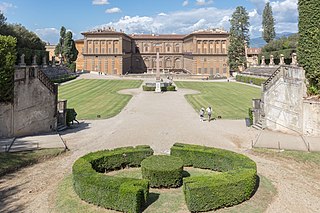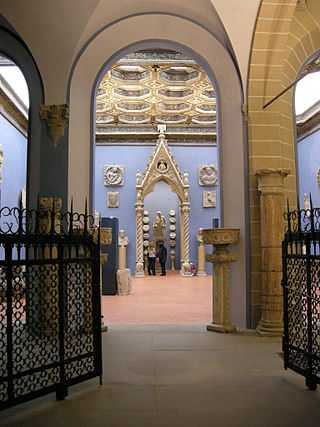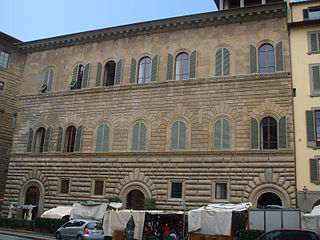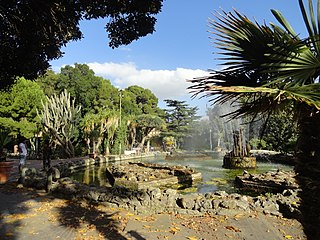
The Boboli Gardens is a historical park of the city of Florence that was opened to the public in 1766. Originally designed for the Medici, it represents one of the first and most important examples of the Italian garden, which later served as inspiration for many European courts. The large green area is a real open-air museum with statues of various styles and periods, ancient and Renaissance that are distributed throughout the garden. It also has large fountains and caves, among them the splendid Buontalenti grotto built by the artist, architect, and sculptor Bernardo Buontalenti between 1536 and 1608.

The Villa Farnese, also known as Villa Caprarola, is a pentagonal mansion in the town of Caprarola in the province of Viterbo, Northern Lazio, Italy, approximately 50 kilometres (31 mi) north-west of Rome. This villa should not be confused with the Palazzo Farnese and the Villa Farnesina, both in Rome. A property of the Republic of Italy, Villa Farnese is run by the Polo Museale del Lazio.

The Forte di Belvedere or Fortezza di Santa Maria in San Giorgio del Belvedere is a fortification in Florence, Italy.

Palazzo Mozzi or Palazzo de' Mozzi is an early Renaissance palace, located at the end of the Piazza de' Mozzi that emerges from Ponte alle Grazie and leads straight to the palace where via San Niccolò becomes via de' Bardi in the Quartiere of Santo Spirito in the Oltrarno section of Florence, region of Tuscany, Italy. The 13th-century palace housed the gallery of the highly successful antiquarian Stefano Bardini, of which the remnants were left to the commune, where they assembled the Museo Bardini or Mozzi Bardini, displaying Florentine art and artifacts up to the early Renaissance. The gardens elaborated against the hillside behind the palace were added mainly by Bardini.

The Orto Botanico di Firenze, also known as the Giardino dei Semplici, the "Garden of simples", is a botanical garden maintained by the University of Florence. It is located at Via Micheli, 3, Florence, Italy, and open weekday mornings.

The Oltrarno is a quarter of Florence, Italy. It is located south of the River Arno. It contains part of the historic centre of Florence and many notable sites such as the church Santo Spirito di Firenze, Palazzo Pitti, Belvedere, and Piazzale Michelangelo.

The Villa Marlia or Villa Reale di Marlia is a late-Renaissance palazzo or villa, and its estate's property that includes renowned gardens and adjacent villas and follies within the compound. It is located in Capannori, in the Province of Lucca, west of Florence, in the northern Tuscany region of Italy.

Villa Rusciano is a historic villa in the neighbourhood of Florence, central Italy, which includes work by Brunelleschi.

The Italian Renaissance garden was a new style of garden which emerged in the late 15th century at villas in Rome and Florence, inspired by classical ideals of order and beauty, and intended for the pleasure of the view of the garden and the landscape beyond, for contemplation, and for the enjoyment of the sights, sounds and smells of the garden itself.

Stefano Bardini (1836–1922) was an Italian connoisseur and art dealer in Florence who specialized in Italian paintings, Renaissance sculpture, cassoni and other Renaissance and Cinquecento furnishings and architectural fragments that came on the market during the urban regeneration of Florence in the 1860s and 70s.

Italian garden typically refers to a style of gardens, wherever located, reflecting a number of large Italian Renaissance gardens which have survived in something like their original form. In the history of gardening, during the Renaissance, Italy had the most advanced and admired gardens in Europe, which greatly influenced other countries, especially the French formal garden and Dutch gardens and, mostly through these, gardens in Britain.

Palazzo Gondi is a palace in Florence, Italy, located a block from Piazza della Signoria. It was built in 1490 under design by Giuliano da Sangallo, who was inspired by other major works of stately buildings in the city, such as Palazzo Medici and Palazzo Strozzi. Among the elements borrowed from these earlier works are the cube-shape set around a central courtyard, the ashlar sloping on each of three floors, and the arched windows.

Giardino delle rose is a garden park in the Oltrarno district of Florence, in Tuscany, Italy. It is located below the Piazzale Michelangelo and offers a commanding view of the city.

The Garden of Archimedes is a museum for mathematics in Florence, Italy. It was founded on March 26, 2004 and opened its doors to the public on April 14 of that year. The mission of the museum is to enhance public understanding and perception of mathematics, to bring mathematics out of the shadows and into the limelight. It has been compared to the National Museum of Mathematics in New York City, the only museum in North America devoted to mathematics.

The Piersanti Mattarella Park, formerly the English Garden, is a public park in Palermo designed in 1851 by the architect Giovan Battista Filippo Basile.


















